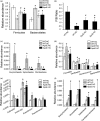Relative variations of gut microbiota in disordered cholesterol metabolism caused by high-cholesterol diet and host genetics
- PMID: 28660729
- PMCID: PMC5552918
- DOI: 10.1002/mbo3.491
Relative variations of gut microbiota in disordered cholesterol metabolism caused by high-cholesterol diet and host genetics
Abstract
Recent studies performed provide mechanistic insight into effects of the microbiota on cholesterol metabolism, but less focus was given to how cholesterol impacts the gut microbiota. In this study, ApoE-/- Sprague Dawley (SD) rats and their wild-type counterparts (n = 12) were, respectively, allocated for two dietary condition groups (normal chow and high-cholesterol diet). Total 16S rDNA of fecal samples were extracted and sequenced by high-throughput sequencing to determine differences in microbiome composition. Data were collected and performed diversity analysis and phylogenetic analysis. The influence of cholesterol on gut microbiota was discussed by using cholesterol dietary treatment as exogenous cholesterol disorder factor and genetic modification as endogenous metabolic disorder factor. Relative microbial variations were compared to illustrate the causality and correlation of cholesterol and gut microbiota. It turned out comparing to genetically modified rats, exogenous cholesterol intake may play more effective role in changing gut microbiota profile, although the serum cholesterol level of genetically modified rats was even higher. Relative abundance of some representative species showed that the discrepancies due to dietary variation were more obvious, whereas some low abundance species changed because of genetic disorders. Our results partially demonstrated that gut microbiota are relatively more sensitive to dietary variation. Nevertheless, considering the important effect of bacteria in cholesterol metabolism, the influence to gut flora by "genetically caused cholesterol disorder" cannot be overlooked. Manipulation of gut microbiota might be an effective target for preventing cholesterol-related metabolic disorders.
Keywords: gut microbiota; high-cholesterol diet; metabolism disorder.
© 2017 The Authors. MicrobiologyOpen published by John Wiley & Sons Ltd.
Figures






References
-
- Antal, G. M. , Lukehart, S. A. , & Meheus, A. Z. (2002). The endemic treponematoses. Microbes and Infection, 4, 83–94. - PubMed
-
- Cani, P. D. , Amar, J. , Iglesias, M. A. , Poggi, M. , Knauf, C. , Bastelica, D. , … Burcelin, R. (2007). Metabolic endotoxemia initiates obesity and insulin resistance. Diabetes, 56, 1761–1772. - PubMed
-
- Conway de Macario, E. , & Macario, A. J . (2009). Methanogenic archaea in health and disease: A novel paradigm of microbial pathogenesis. International Journal of Medical Microbiology 299, 99–108. - PubMed
Publication types
MeSH terms
Substances
LinkOut - more resources
Full Text Sources
Other Literature Sources
Medical
Miscellaneous

